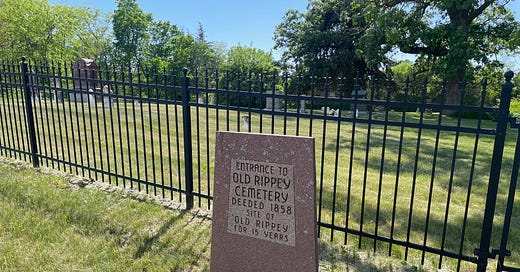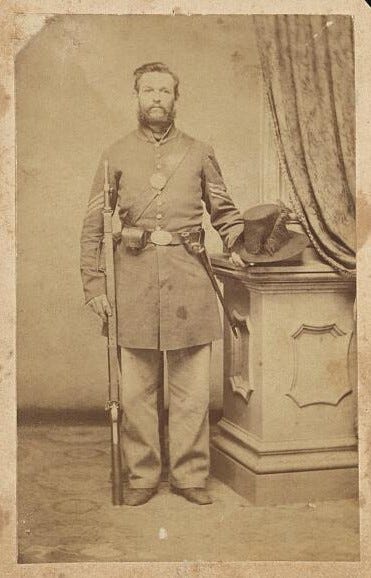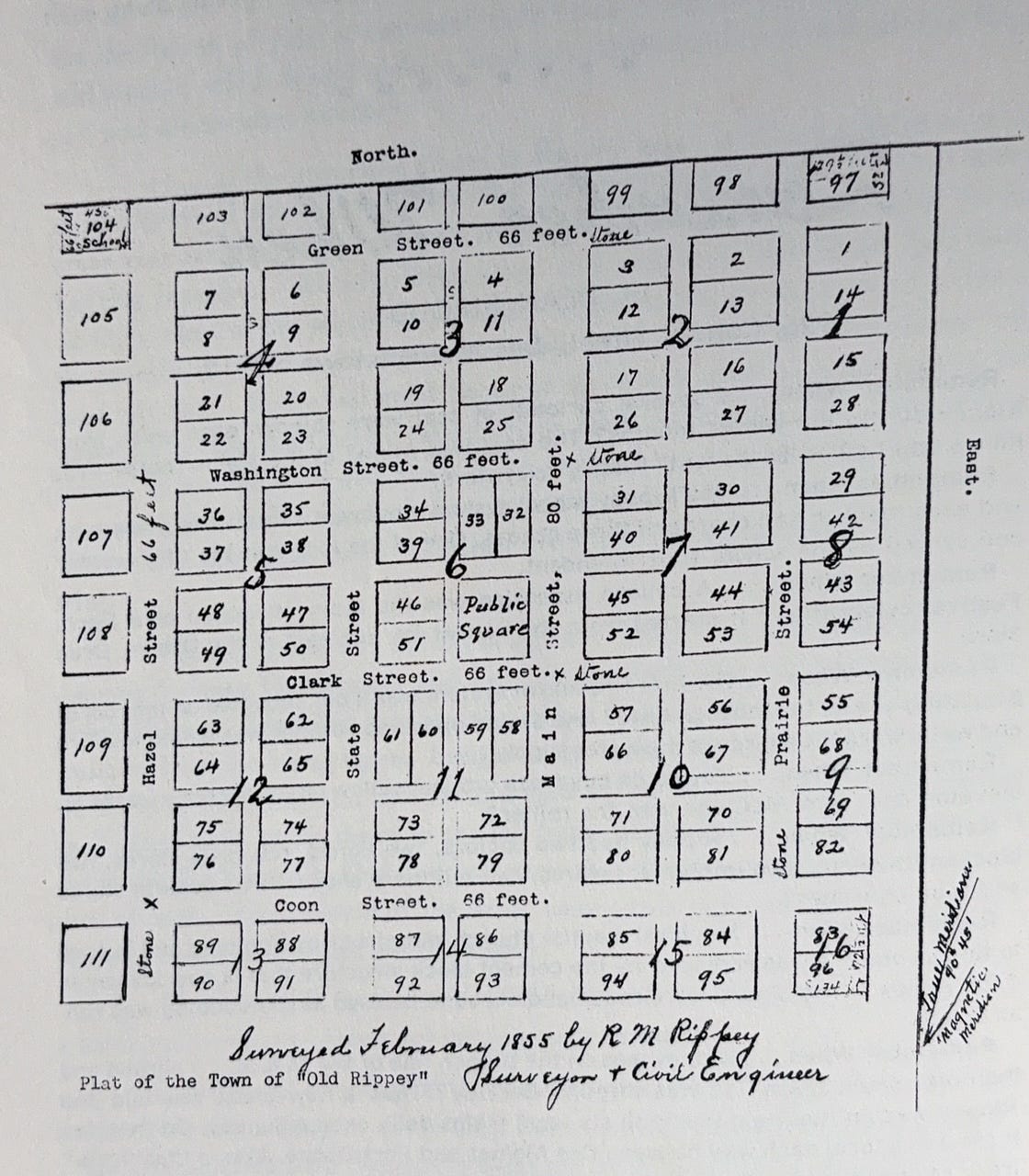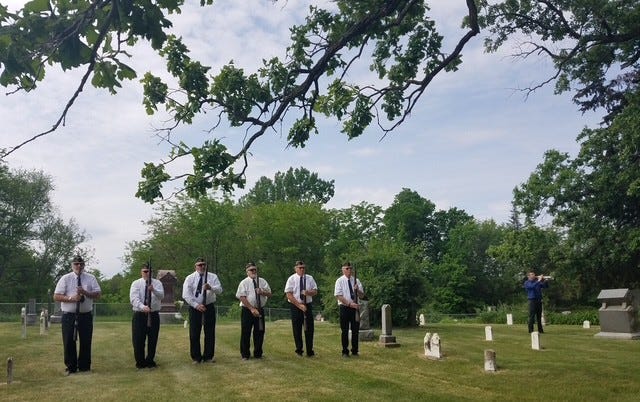Our little-known Civil War valor
In Greene County, Iowa, today’s high school students help us recall & honor 32 schoolboy soldiers & two teachers enlisting from the town Old Rippey. Ten died.
JEFFERSON, Iowa – The email back in April from Dena Boyd, a history teacher at Greene County High School here, told how she was leading her students in an Iowa history class “into a local history unit. My intention is to focus on places around the county, as well as the people of Greene County who’ve made an impact.” She asked if I would come speak to her classes and share stories “that high schoolers could maybe relate to” about impactful people in this county.
On April 17, I did.
And as a result, six local high school boys – two graduated last weekend – committed to get a memorial erected in a public place, telling a 162-year-old story about the schoolboy soldiers of Old Rippey, Iowa, who volunteered and served in the bloody Civil War.
It is, I told the students, “the most under-told and under-appreciated story in Greene County history.” The students of today definitely related to it.
The Old Rippey Cemetery, where some of the schoolboy soldiers in the Civil War are now buried.
In a month of research, the GCHS boys learned and wrote about how in 1862, there were 32 students, plus teacher Azor Mills and his “sub-director” Isaac Brown who marched off to war together. They had been part of the first school built in the newly-formed Greene County, which was not yet a decade old.
“The 34 gave up their education to join in the fight against the South, even when it didn’t affect them as much as others,” today’s students, led by senior Oliver Harris, reported. His research group included another senior Kaiden Burbank, sophomores Moses Brown and Ethan Carstens, and freshmen Collin Russell and Yaakov Gehling.
“They joined the 39th Iowa Army Group as Company E,” the GCHS students’ report continues. “In that company were fellow people from the Greene County community. They trained in West Des Moines in 1862, then later saw action in various campaigns, including the ‘Expedition after Wheeler,’ and the Campaign of the Carolinas. An important battle they participated in was the Battle of Altoona Pass in Georgia, where someone has said that no one has fought harder than the 39th Iowa. Of the 34 who served, 10 died during the war, with two dying in one of the worst prisoner camps during that time,” the notorious Andersonville Prison the Confederates operated in Georgia.
The grave of Van Beuren Brand, marked with the star of the Grand Army of the Republic, designating a Civil War veteran.
It seems appropriate, on this Memorial Day weekend, to list the names of the Old Rippey school contingent that went to the war, according to the research by today’s students. Those designated as “deceased” died in combat or from diseases contracted during the war.
John W. Adkins, Deceased
William L. Adkins
John Athey
Van Beuren Brand, Deceased
G.B. (Banger) Burk
Archibald Burk
Phillip Cline
Levi P. Davis
William M. Davis
John H. Davis
Milton Evans, Deceased
James M. Evans
Hardin Hall, Deceased
Daily B. John, Deceased
John B. John
Dave John
Lewis John
Thomas Martin Lee
Joseph Myers
Henry R. Myers
John Myers
John Rhoads, Deceased
James W. Smith
Robert T. Smith, Deceased
Abraham Scott
Thomas Turpin, Deceased
Marion Toliver
John H. Toliver, Deceased
Gillum S. Toliver
Jacob M. Toliver
James C. Toliver
Isaac H. Brown, Sub-Director, Deceased
Azor R. Mills, Teacher
You can still find many of those surnames in Greene County today.
Azor Mills, early teacher in the Old Rippey school and Civil War veteran.
Two other interesting points the research by Ms. Boyd’s students turned up:
--You’ll note there were three Myers brothers among the Old Rippey schoolboy soldiers. Their father Berlin Myers hand-made them a large drum to take with them and use in military service. That drum is now in the Greene County Historical Museum. Post-Civil War, it was occasionally used for cadence in community parades around the county.
--“A funny story,” the GCHS students report, “is that when they (the Old Rippey schoolboys) showed up in Des Moines, they didn’t have enough money for shoes, so they painted their feet black so they could still march.”
There is no sculpture or plaque or other public display in Greene County today that makes this story easily accessible for people. Yes, it lives in the archives of the Greene County Historical Museum in Jefferson. And, yes, a few of us old timers recall stories that descendants of the Old Rippey soldiers would tell. But most people today are unaware.
“That gives me goosebumps!” Deb McDonald, the Greene County recorder, said the other day after I told her about it. She then launched a search for land records of Old Rippey and found them.
That town in southeastern Greene County was first platted in 1855 in Washington Township – about 2.5 miles west of the current town of Rippey (pop. 214, per the Census estimate for 2023). The first Rippey lasted 15 years before the townsite was officially moved east to the townsite that the newly-arrived railroad had designated. All that remains in Old Rippey is the beautiful cemetery, now designated a “pioneer cemetery,” with about 50 apparent graves in it. Two or three of those hold the remains of the schoolboy soldiers from the Civil War.
Richard Bardole, of Rippey, caretaker of the Old Rippey Cemetery, was surprised to hear the story of how the students went to war. “I had not heard that story,” he told me. “But that makes it even more special out there.”
The 1855 plat for the town of Old Rippey, Iowa.
The school that was built and operated briefly there is noted in some records and histories as the “Brand School,” perhaps named after the family that may have donated the land for it. It was built from native lumber, milled on the site. The builders were all from the rural area of five miles surrounding Old Rippey.
It was the first school in Greene County, and it operated on the “subscriptions,” or tuition, that the pioneer parents would pay for their kids to attend.
Azor Mills, the teacher, later recalled that about 60 students enrolled over the years and that number “included those from ages 10 to about 25 – at least two-thirds of them boys.”
Greene County’s public support for the Union cause in the Civil War can hardly be overstated.
Early county newspaper editor E. B. Stillman wrote about that in the 1907 history book “Past & Present of Greene County, Iowa.”
“It is a remarkable historical fact that Greene County, with a scant population, not yet 1,400 (at time of the war’s outbreak in 1861,) should have furnished 150 men who willingly enlisted in the war for the Union,” Stillman reported.
And we now know who 34 of them were.
The south lobby of the courthouse in Jefferson has the “Honor Roll of Greene County” — the listing of all county veterans in all wars — in the cabinet. But there is no specific memorial anywhere saluting the service of the Old Rippey schoolboy soldiers in the Civil War.
Billie Johnson-Daves, the new administrator of Veterans Affairs for Greene County, dug into records last week and determined that there are “approximately 456” veterans of the Civil War who are buried in the county. Of course, many of those undoubtedly enlisted elsewhere but eventually settled here.
The story has been researched by many people over the decades. I chanced on a story on the internet, “Tales of Old Rippey school told,” by a Nancee McMurtrey Seifert in 2009. I was unable to contact her now.
She wrote how, in 1887, Azor Mills had reflected on the Civil War history, apparently for early Greene County newspapers.
“I will speak of one of Washington Township’s early schools, on account of its patriotism and loyalty,” Mills wrote about his students who “wore the government blue against the slave holders’ rebellion.”
He gave this report of casualties: “Brown fell commanding his company at Champion Hill, Miss; Milton Evens was mortally wounded at Charleston, Mo.; Hall fell at the madly contested battle at Altoony Pass, Ga.; John W. Adkins and Robert smith died at Andersonville. Marion and John Toliver, John Roads, Thomas Turpin and Daily Johns died in the army (of disease); Van Beuren Brand died at home from army exposures. Most of the others were wounded, some very severely and some more than once. The survivors returned to civil life to be good and honorable citizens, and quite a number have filled places of trust and honor.”
Mills concluded his report with what must have been one of his troops’ rallying cries: “If the state of Iowa can find a county school with a better war record, the survivors of this school will give them nine cheers and a tiger!”
The hand-made Civil War drum that the Old Rippey schoolboy soldiers used, now displayed in the Greene County Historical Museum in Jefferson. (Historical society photo)
The Old Rippey schoolboy soldiers’ war record is one of the most startling and inspiring Civil War stories I know.
There are two others, though, that are equally startling that Greene Countians, especially, might want to read more about as we consider what kind of memorial we will erect here.
One is the account of how six brothers in the Littleton family near Fruitland in southeast Iowa’s Louisa County lost their lives in Union service in the war. Their story was forgotten and lost in that county 150 years before an out-of-stater called their local historical society in about 2010 when he found a faded news clipping. Further research revealed that the Littleton brothers were the sons of a Black father and white mother. An appropriate new monument to the Littletons was erected on the historical society’s grounds in Toolesboro in 2015, with then-Gov. Terry Branstad helping the project financially. You can read more about all that here: https://littletonbrothers.com/story.
Another story about students going to the Civil War –although these students were likely a little older than many of ours – was at the former Lenox College, a Presbyterian-affiliated school in the small town of Hopkinton in northeast Iowa. “During the Civil War, 92 Lenox students served in the Union Army, with the president, Reverend James McKean, acting as their captain,” a local history reports. “McKean and 46 of the students were killed in service.” You can read about the memorials on the former campus of the college, which closed in 1944, here: https://www.lostcolleges.com/lenox-college.
Oliver Harris, 17, the now-graduated senior who led the initial research into the Old Rippey story by today’s GCHS students, said “when we first heard about this story from you, it was really striking to us how so many people, as soon as the war started, gave up their lives and enlisted, including those young students. They were in intense battles. They learned how bad war was. For the survivors, the physical and mental challenges must have been astronomical when they came home from those experiences.”
Harris said his group “thought it was kind of crazy that there isn’t a public marker telling the story. What we decided is that the right place for something like that would be inside or outside the courthouse, since it represents everybody in Greene County, and since a lot more people would see it there. The story should be about all those from here who served in the Civil War, even though the focus could be about the 34 from Old Rippey. It’s such a great story! It really tells you about the character of the people around here.”
Yaakov Gehling, 15, who accepted leadership of the student group after Harris’ graduation, said he wants to the marker “to show how, despite their young age, when the war started, the (Old Rippey) students didn’t sit around and wonder whether to get involved. They all stepped up and enlisted. These days, would that happen?”
Oliver Harris, a graduated senior who has led the group of Greene County High School students planning a memorial for the Old Rippey schoolboy soldiers. (GCHS photo)
Kaiden Burbank, another graduated senior among students who are advocating a memorial. (GCHS photo)
The four underclassmen working on the memorial are (left to right) freshman Collin Russell, sophomore Moses Brown, sophomore Ethan Carstens, and Yaakov Gehling. (GCHS photo)
The group did phone-conference interviews with me, Mary Weaver and Dianne Piepel. All three of us have been involved with the Greene County Historical Society.
Dianne, who is now co-director of the historical society with her husband Mike Piepel, helped the students find books and resources in the museum archives. Included were excerpts from a priceless archive the museum has – a 239-page diary of Gillum Toliver, one of the Old Rippey schoolboy soldiers. Toliver was the great-grandfather of the late John Milligan, who for years served as city engineer in Jefferson.
“It’s wonderful the high school students now are interested in this,” Dianne Piepel said. “I was glad to work with them. We like getting young people in here at the museum.”
She was so impressed with their interest and their work that she reported about the project to the board of directors of the historical society at their recent meeting. The board voted to support the students’ effort – both in principle and financially – in having an appropriate marker created and placed.
I’m committed financially, too, and we’ll accept donations from others once preliminary plans and cost estimates are completed.
Meanwhile, GCHS history teacher Dena Boyd said the project is providing a nice wrap-up to her Iowa history course. It was her first-year teaching here after 14 years teaching at neighboring Ogden High School.
“After you talked to the students about so many people and events that are notable in Greene County history,” she said, “I asked them if there was one person or thing that most interested them. Fifteen of my 30 kids said it was the Civil War solders from Rippey.”
She said as a final assignment, she required all students “to do some report or project about life in Greene County. They had to reach out to people outside of school, talk to them, and come back with a report. The six boys came back and said they wanted to work together in a follow-up on the Rippey soldiers. I gave them a couple names and phone numbers, and that’s all I did. They did the interviews, went to the museum, got their resources and put their report together. Each time they’d talked to somebody, they’d come back excited, saying, ‘Did you know…!’
And thanks to the GCHS student researchers, now the rest of us will know more, too.
The Honor Guard of the Kincaid Martin Post of the American Legion, of Rippey, making their annual Memorial Day salute at the Old Rippey Cemetery. (Photo courtesy of Sharon Ulrich)
You can comment on this column below or write the columnist directly by email at chuck@offenburger.com
--
Have you explored the variety of writers, plus Letters from Iowans, in the Iowa Writers’ Collaborative? They are from around the state and contribute commentary and feature stories of interest to those who care about Iowa. Please consider a paid subscription. It helps keep them going, and it keeps you in the know.














What a terrific story, Chuck! Thank you for sharing it and helping us all to remember their valor, bravery and sacrifice.
Reading this article brought tears to my eyes. What a wonderful history lesson, an inspiring teacher, motivated students and a plan for bringing the courage of so many young Iowans and their story to light👏👏